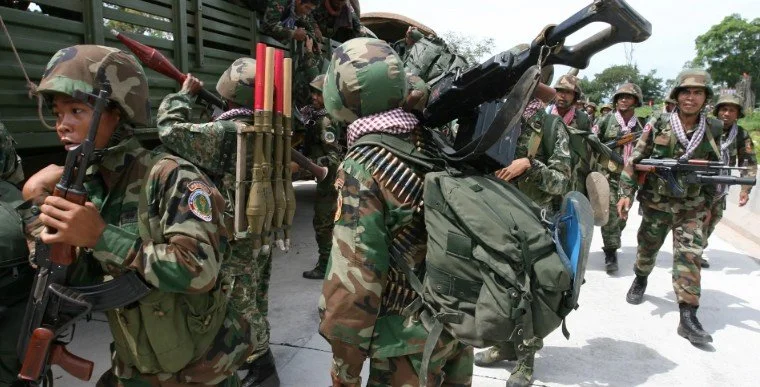Weaponising the Law: Thai–Cambodian Border Conflict and Lawfare in the Indo- Pacific
1. Introduction
Toward the close of July this year, hostilities erupted along the Thai-Cambodian border, centring on the disputed territory surrounding the ancient Khmer-Hindu temple of Ta Moan Thom. Both countries have accused the other of being the aggressor, with international law being featured prominently to legitimise and justify actions taken by both nations.
This conflict provides a vivid illustration of how international law is increasingly being weaponised as a strategic tool in interstate conflict—a phenomenon known as lawfare. Traditionally understood as the use of law to achieve military ends, the concept can be extended to the use of law to legitimise operations in the broader political and strategic arena. This commentary will examine the way lawfare has been used in this conflict and its consequences for the Indo-Pacific.
2. Use of Lawfare by Cambodia and Thailand
Both Thailand and Cambodia have used international law to garner international support for their side of the conflict. In a letter to the UN General Assembly (UNGA), Phnom Penh accused Thailand of illegal incursions into its territory, referencing maps endorsed by the International Court of Justice (ICJ) from its decision granting sovereignty of the Preah Vihear Temple to Cambodia. Cambodia has called on both UNGA and ICJ to intervene to resolve this conflict, with Prime Minister Hun Manet stating that the issue is too complex and volatile for bilateral mechanisms to solve.
Cambodia’s invocation of the ICJ has both political and military uses. Politically, the Court’s ruling confirming Cambodia’s sovereignty over the Preah Vihear Temple has become a rallying point for patriotism, reinforcing the official narrative of Cambodia as the victim of foreign aggression. Internationally, it also portrays Cambodia as committed to resolving disputes peacefully through international law, even though satellite data suggests that Cambodia has actually done more to escalate the conflict than its counterpart. By internationalising the conflict, Cambodia can show itself to be committed to peace while also escalating military operations on its own terms against Thailand’s much larger military.
Similarly, Thailand uses international law to delegitimise Cambodia’s military actions while justifying its own. In particular, Bangkok accuses Phnom Penh of planting landmines in breach of international treaties; such breaches, Bangkok claims, trigger its inherent right of self-defence under the UN Charter. While internationalising the landmine issue, Thailand has maintained that the border issue should be resolved bilaterally through mechanisms like the Joint Border Commission (JBC) and refuses the ICJ’s jurisdiction. By selectively emphasising the landmine issue while simultaneously rejecting the ICJ’s rulings and jurisdiction, Thailand can show itself to be committed to the rules–based order while also legitimising its own military actions.
3. Great Power Lawfare
This conflict also shows how lawfare can be employed by Indo-Pacific great powers, like the U.S. and China, to forward their own strategic interests. The Trump administration, in particular, has used international trade tariffs and treaties as instruments to pursue broader diplomatic and security objectives. In the context of this conflict, Washington sought to condition the easing of tariffs on a cessation of hostilities. This illustrates the shift in U.S. policy toward using bilateral economic coercion to pursue strategic objectives, with those objectives increasingly defining the baseline for economic relations. That said, the United States has not been absent in intermediary roles; it joined China in the ASEAN five-party talks and worked with host Malaysia to broker the ceasefire agreement, even as Trump preferred informal channels of communication.
In contrast, China has more strongly sought to position itself as a mediator, highlighting the role of regional bodies such as ASEAN, while simultaneously expanding its own influence. Beijing has repeatedly praised ASEAN — an organisation where its influence is growing— while presenting itself as an intermediary between the two parties. Some commentators suggest that this gives Beijing an opportunity to bring in its newly minted International Organisation for Mediation (IOMed), of which Cambodia is a member, strengthening its regional and institutional reach. This strategy is bearing some fruit, with leaders from both Thailand and Cambodia meeting with the Chinese foreign minister in August after the second ceasefire was agreed upon. Nonetheless, there is some scepticism, particularly from the Thai side, regarding China’s supposedly neutral role, considering the close trade and military ties between the Chinese and Cambodian governments.
4. Conclusion
Lawfare is alive and well in the Indo-Pacific. From maritime disputes to border conflicts, law is used by countries big and small to achieve their strategic goals. The Thai–Cambodian case exemplifies how lawfare can entrench the role of law, but at the cost of eroding its credibility as a genuine constraint on state behaviour. For the Indo-Pacific rules-based order, the challenge lies in ensuring that law remains more than a weapon and continues to function as a stabilising framework for regional security.
Tristan Eng is an intern with the Stockholm Center for South Asian and Indo-Pacific Affairs and an Emerging Scholar at the Indo-Pacific Studies Center. He is also affiliated with the Journal of Territorial and Maritime Studies and the Yokosuka Council on Asia-Pacific Studies. His research focus is international law and regional governance in the Indo-Pacific.


